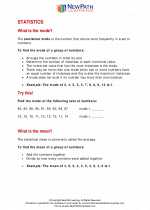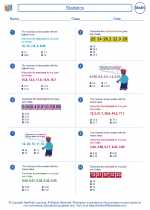Pictographs
A pictograph is a way of representing data using pictures or symbols. Each picture or symbol in a pictograph represents a certain number of items or a certain value. Pictographs are a visual way to display information and make it easier to understand and interpret data.
Key terms related to pictographs:
- Data: The information that is being represented in the pictograph, such as numbers, quantities, or values.
- Symbol: The picture or icon used to represent the data in the pictograph.
- Frequency: The number of times a particular symbol appears in the pictograph, representing the quantity or value it stands for.
- Scale: The relationship between the frequency of the symbols in the pictograph and the actual quantities or values they represent.
Creating and interpreting pictographs:
To create a pictograph, follow these steps:
- Choose a suitable symbol to represent the data (e.g., a picture of an apple to represent the number of apples sold).
- Determine the scale for the pictograph, i.e., how many units each symbol will represent (e.g., each apple symbol may represent 10 apples sold).
- Draw the symbols on the pictograph, making sure to use the scale to represent the correct quantities or values.
- Add a key or legend to the pictograph to explain the meaning of the symbols and the scale used.
To interpret a pictograph, look at the symbols and their frequencies to understand the data being represented. Pay attention to the scale and the key to accurately interpret the quantities or values represented by the symbols.
Example:
Imagine you are creating a pictograph to represent the number of books read by students in a week. You decide to use a book symbol to represent the data. Each book symbol will represent 5 books read. After collecting the data, you draw the book symbols on the pictograph and include a key to explain the scale and the meaning of the symbols.
Here's an example of how the pictograph might look:

In this pictograph, each book symbol represents 5 books read. The key indicates the scale and the meaning of the symbols, making it easy to interpret the data.
Practice questions:
- Create a pictograph to represent the number of ice cream cones sold in a week at an ice cream shop. Use an ice cream cone symbol to represent the data, with each symbol representing 10 ice cream cones sold. Include a key to explain the scale and the meaning of the symbols.
- Interpret the following pictograph, which represents the number of cars sold by a dealership in a month:

Now that you have a good understanding of pictographs, practice creating and interpreting them to strengthen your skills in representing and understanding data visually.
[Pictographs] Related Worksheets and Study Guides:
.◂Math Worksheets and Study Guides Fifth Grade. Statistics

 Worksheet/Answer key
Worksheet/Answer key
 Worksheet/Answer key
Worksheet/Answer key
 Worksheet/Answer key
Worksheet/Answer key
